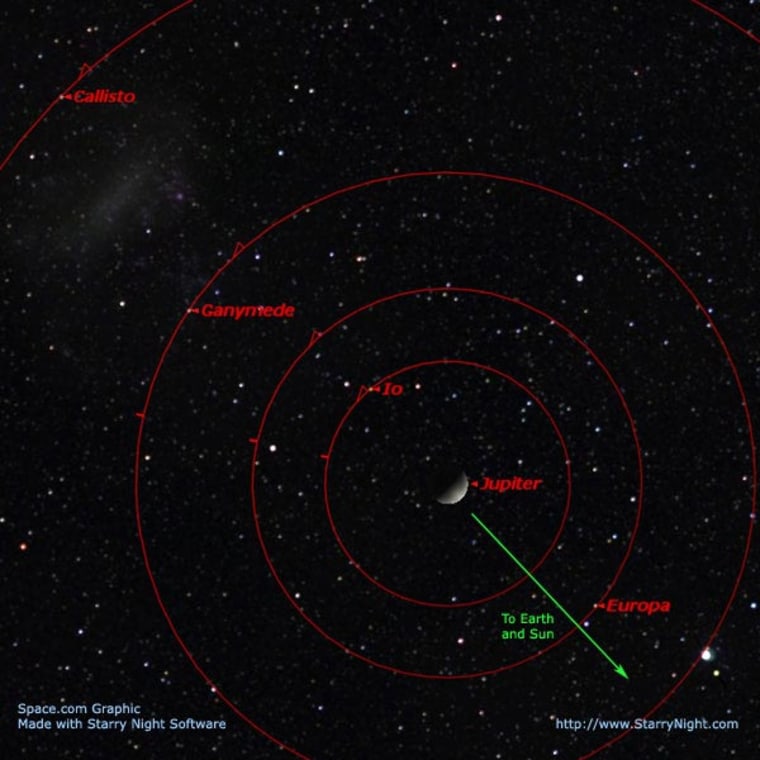This week, the giant planet Jupiter, poised against the stars of Sagittarius, looms up into view low in the southeast in the middle of the night. It rises around 11:30 p.m. local daylight time, and is best seen in telescopes just before morning twilight, when it's fairly high in the south or southeast. A medium-size telescope of high quality on a night of good seeing will show the disk of this creamy white giant richly, though subtly patterned.
Anyone who points a small telescope toward the planet Jupiter will nearly always see some or all of the four famous "Galilean" satellites, first seen by Galileo in 1610. Usually at least two or three of these big moons are immediately evident, sometimes all four. They appear as tiny stars in small telescopes and even steadily-held binoculars.
Conversely, it is rather unusual when only one moon is in view and rarer still when no moons at all are visible, as will occur next week for skywatchers in select locations in Eastern North America. On such occasions when all four are simultaneously invisible is it because:
They are passing across the disk of Jupiter (in transit), They are behind Jupiter (in occultation) or They are within Jupiter's shadow (in eclipse).
Historical perspective
The first-ever recorded observation of Jupiter "Without a Visible Satellite" was apparently made in 1681. Writing about this lone episode in his book, A Cycle of Celestial Objects, in 1844, William Henry Smyth commented that this was "... a conjunction which will require more than three thousand billions of years to occur again."
Smyth's estimate, however, was a humongous exaggeration. While such "moonless" occasions are indeed rare, they actually occur about 20 times per century. Gian Vincenzo "Enzo" Mora of Sequals, Italy made the first extensive calculation of Jupiter's moonless occurrences in 1909. His listing, obviously intended to be exhaustive, spanned the entire 19th and 20th centuries. The studies of Mora were meticulous, and no doubt required a tremendous amount of time, and all without the aid of modern computers!
Modern studies, using computer technology have demonstrated that Mora's computations were incredibly accurate, although he did overlook three occasions (in 1859, 1895 and 1962) when Jupiter appeared without satellites.
A new set of predictions was recently drawn up by the well-known Belgian astronomical calculator, Jean Meeus, for the period from 1900 to 2100 AD. And as it turns out, one of those opportunities to see Jupiter with no moons is presented this week.
Tough to see!
Slideshow 12 photos
Month in Space: January 2014
This upcoming event will coming during the late evening hours of Wednesday, May 21, but unfortunately will be only be visible along the Eastern Seaboard of the United States, as well as the Canadian Maritime provinces. Even in these locations, visibility will be a challenge, for the "moonless interval" will begin only minutes after Jupiter rises and it will only last 19 minutes! Farther to the west, across the rest of the United States and Canada, at least a couple of the moons will have already emerged into view by the time Jupiter rises.
At 11:50 p.m. Eastern Daylight Time on May 21 (or 12:50 a.m. Atlantic Daylight Time on Thursday, May 22), the situation in regard to the four satellites will be as follows:
Io, the innermost Galilean moon, will become eclipsed by Jupiter's shadow. Europa will be in transit, passing across Jupiter's disk. Ganymede will be out of view behind Jupiter's disk in occultation. Callisto, the outermost moon, like Io, will also be in eclipse. Io will be the last to disappear.
Then, 19 minutes later, at 12:09 a.m. EDT on May 22 (1:09 a.m. Atlantic Daylight Time), Ganymede will emerge from behind Jupiter.
For those living along the immediate US East Coast, Jupiter will be very low at that time – depending on your location – only about 3 to 6 degrees above the east-southeast horizon. This means having to view Jupiter through the perpetual haze layer lying near to the horizon. Its brilliance will almost certainly be attenuated, and its image is likely to appear as if it were "boiling" or fuzzy as you gaze at it through our turbulent atmosphere. Nonetheless, it might still be worth a try.
In contrast, a much better view will be available from the Caribbean. From San Juan, for instance, Jupiter will stand more than 20 degrees above the horizon when all four moons are out of sight (your clenched fist held at arm's length measures 10 degrees). And much of South America will also see Jupiter well above the horizon when the Galilean satellites vanish.
Another (much better) chance
If you miss out seeing Jupiter without satellites, you can at least be consoled in knowing that there will be another, much better chance less than 16 months from now, on the night of September 2-3, 2009. That event will take place in the middle of the night for North America, with Jupiter appearing well up in the southern sky. And best of all, the four moons will be out of sight for almost two hours.

